Bicoastal Big Day – NYC to SF
By Alan Hopkins
I awoke to the clanging and clashing of the garbage trucks outside my window. It was 2 a.m. When I listened carefully, I could also hear tires splashing on Manhattan’s rain-wet West 22nd Street below. Not what I wanted to hear. The alarm was set for five; I needed my sleep for the long day ahead. But I tossed and turned. I wondered, Would I see any birds? Would I miss our flight? Would I get soaked and have to spend five hours wet on the plane?
Then I had a small epiphany. I should get off the subway at 72nd Street and not 86th Street as planned! Eventually I fell asleep and eventually the alarm went off at five. I dressed in the bathroom to keep from waking my wife Julie. I grabbed my pack and headed for the elevator.
I couldn’t believe I was actually doing this crazy New York to San Francisco Big Day again. The idea was to see birds in Central Park in the morning, hop on a plane, and bird in San Francisco in the afternoon — while raising money for Point Blue’s Rich Stallcup Bird-a-thon. I’d done this bicoastal Big Day once before and had a good morning in the park but was squeezed in San Francisco by a very slow shuttle and fog along the coast.
I’ve done many and varied big days before. Dan Murphy and I started the Bird Blitz some time in the early 70s before county listing was in vogue. Our Golden Gate Bird Alliance team, the Loonaticks, did GGBA bird-a-thons that started in Los Banos and ended in Pescadero to raise funds to save Mono Lake. I’ve been doing San Francisco County big days to raise funds for research on the Farallon Islands for more years than I can count. Our best — and the S.F. Big Day record — is 149 species.
It just happened that I was in New York the weekend we usually do our S.F. County big day. And it just happened that Julie arranged our flight back to San Francisco in a way that would allow me a bit of birding time in the morning and a bit more time in the afternoon. It was clear that I needed to try this exotic big day again. After all how many times can you see Great Black-backed Gull, Heermann’s Gull, Blue Jay, California Scrub Jay, and Steller’s Jay all in the same day?
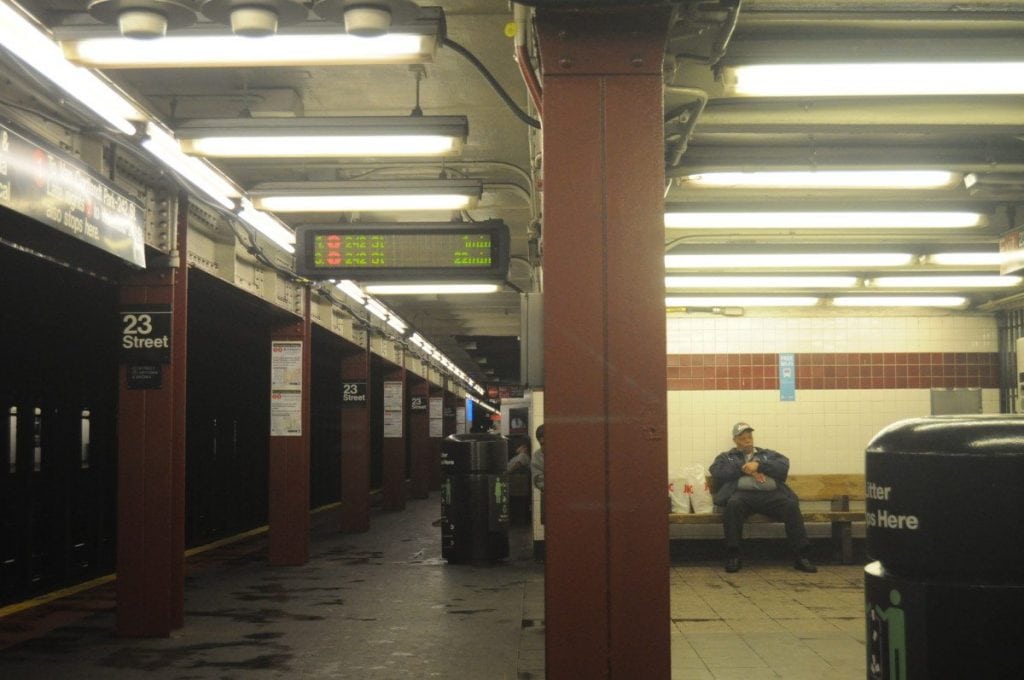
Down the elevator and out the door at 5:30, it was raining lightly. Then down the steps to the 1 train at 23rd street. Except for a few people pulling all-nighters on benches, the uptown platform was empty. The subway was prompt and in no time I was exiting at 72nd Street. Then I found my first bird under the streetlights at 72nd and Columbus Avenue: a House Sparrow. I walked past the Dakota apartments (home to John Lennon), crossed Central Park West, and entered the park’s Strawberry Fields.
I found a bench that wasn’t too wet under a streetlight and had my breakfast of Red Bull and a bagel. I’d hoped to hear a few birds before it was light enough to see, but I heard nothing. I headed for the Bow Bridge, and along the way found a rat and a raccoon. From the bridge’s apex, I saw some Mallards on the Lake, and a Black-crowned Night-Heron squawked in the distance.
The sky lightened a bit, a few robins began to cackle, and the first brave joggers headed into the Ramble. Just as I believed I might hear more birds, a dedicated park employee decided that the predawn hours in the rain were a good time to scrape the weeds from the roadbed with a shovel. I wasn’t going to hear anything.
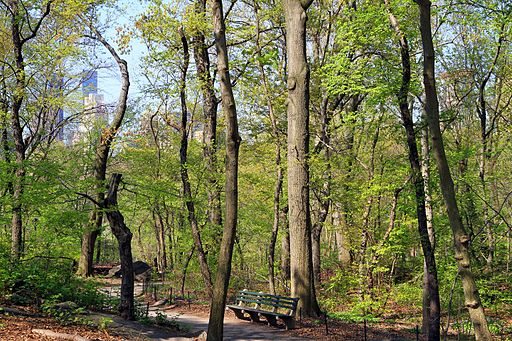
I headed into the Ramble, which is one of Central Park’s most naturalistic areas with small streams and ponds and a maze of trails that provide some of the park’s best birding. The Ramble’s thick canopy made it too dark to see, but along the lake’s edge it was light enough to search for the Waterthrush I’d seen the day before and watch for a Ruby-throated Hummingbird visiting flowers. Both were no shows.
The dawn chorus sputtered to a start, so I headed into the thick of the Ramble. The morning calls were only from the most common birds. Then I spotted a flycatcher silhouetted against the gray sky. With rain collecting on my lenses, it was hard to get field marks other than shape. After five minutes of trying to get better looks at the bird, I determined that it was an Eastern Phoebe and that it was still too dark to see in the Ramble. I headed for Maintenance Meadow, where the dawn was providing enough light to see decently. After some searching I found an Eastern Towhee. It started raining harder so I headed for the gazebo at Belvedere Castle to stay dry.
Belvedere Castle sits atop appropriately named Vista Rock. In the distance, I could see clouds scraping the city’s high-rises, and the Great Lawn and Turtle Pond below. In the gazebo’s ceiling beams, European Starlings (Sturnus vulgars) gathered to screech and squawk as if to make everyone fully aware that this is where their distant relatives were first released in 1890. The starlings didn’t seem to bother the guy crashed out in the corner; it seemed to be his spot too.
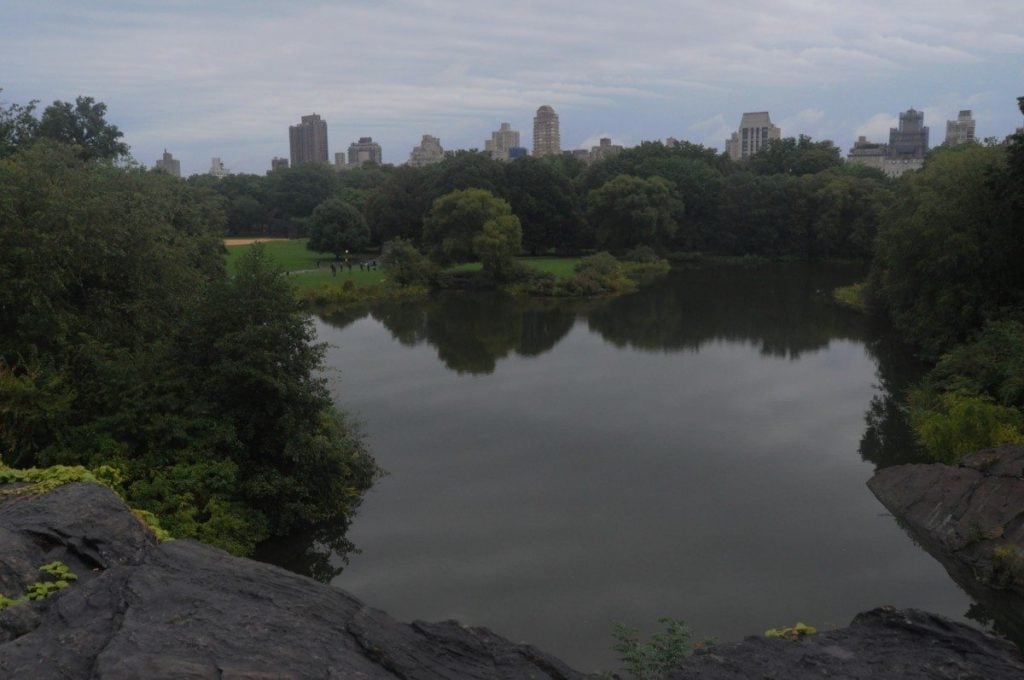
A few Great Black-backed Gulls flew over, then a Herring Gull. Young Blue Jays frolicked at the cliff’s edge. From my previous days’ scouting, I knew that the morning sun hit the trees around the castle before other parts of the park. On two days of scouting, I found 14 species of warbler, plus vireos and other migrants moving through the park. Unfortunately there was no sun and no migrants this morning. It was time for me to head toward the subway at 81st Street. I was a bit early so I decided to check a grove of trees near Central Park West for a White-throated Sparrow. No sparrows, but at the last moment two Black and White Warblers flew onto a tree a few feet away — my last birds in New York.

I caught the southbound sardine-packed C train to 23rd Street. I crossed Eighth Avenue, where Julie and her mother Sonia were waiting. We said our goodbyes, headed back down into the subway, and caught the uptown E. An hour later we were at JFK. There were rifle-toting solders stationed in the lobby, but we breezed through security. During an hour’s wait at the Jet Blue gate, I scanned the sky for Ring-billed Gulls and Chimney Swifts — nothing.
Five hours later, we landed at SFO ahead of schedule and Mark Eaton met us promptly at the arrivals gate. Mark was feeling a bit under the weather but agreed to join me all the same. His help was vital to making the San Francisco leg of the trip a success. Instead of depending on a shuttle, Mark picked us up in his Prius and his extra pair of eyes were invaluable. Our first stop was at the SamTrans Bus Yard where we found Meadowlarks, Forster’s Terns, Avocets, Stilts, and other shorebirds. The tide was far out, and we could have seen more if we had the time to walk to the end of the peninsula, so we did the best we could with Mark’s scope. Julie, who is not a birder, was waiting patiently in the car: Our next stop was to drop her off and pick up my scope.
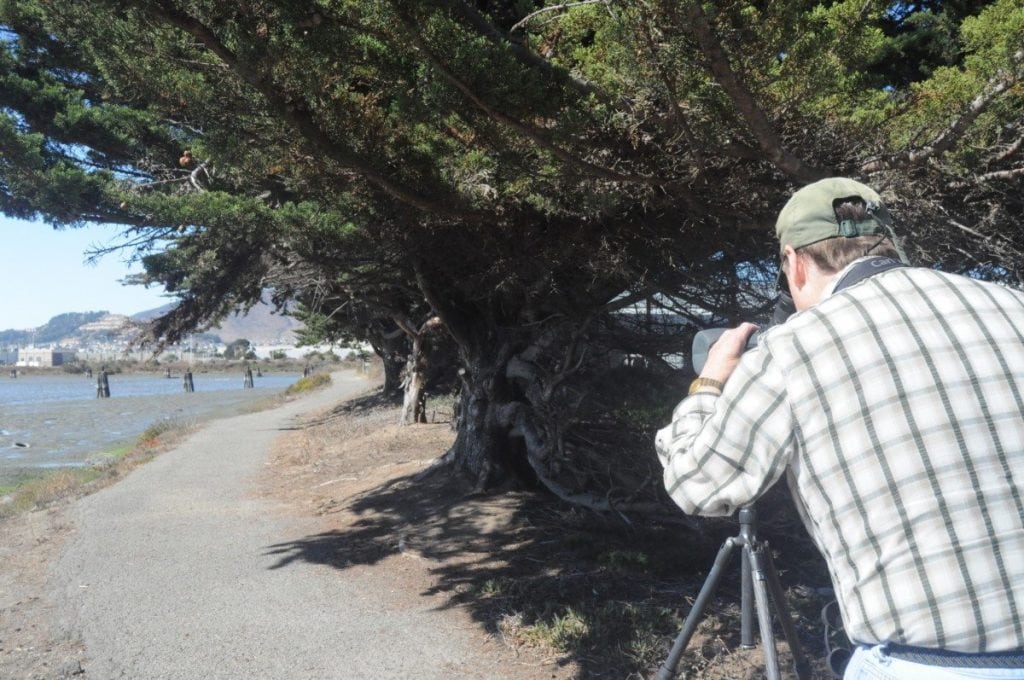
We entered Golden Gate Park at 9th Avenue and managed to find parking right in front of Strybing Arboretum. We checked the hybrid Monkey Hand tree at the gate, but there was nothing there. At Stow Lake, we found the Hooded Merganser and some of the city’s common birds but no Great Blue Herons.
We checked the lakes and ponds along JFK Drive and stopped at the Bison Paddock. At the paddock, we pished and squeaked at the native scrub plantings and the open field holding the bison. It took a few minutes but White-crowned, Golden-crowned, Song, and Fox Sparrows popped up to have a look. A tourist asked what we were doing. It’s hard to explain when you’re in a hurry. Our best stop was at North Lake. We found “Western” Flycatcher, Ruby-crowned Kinglet, Orange-crowned Warbler, Yellow Warbler, Townsend’s Warbler, and Yellow-rumped Warblers. Not bad for a late foggy afternoon. We headed for the Cliff House and Seal Rocks.
It was absolutely socked in with fog. I scoped Sutro Baths and could make out Heermann’s Gulls and the best bird of the day — a Common Merganser. Scoping from the Cliff House, Seal Rocks were just silhouettes. I couldn’t make out any birds at all — the same thing that happened on my previous attempt.
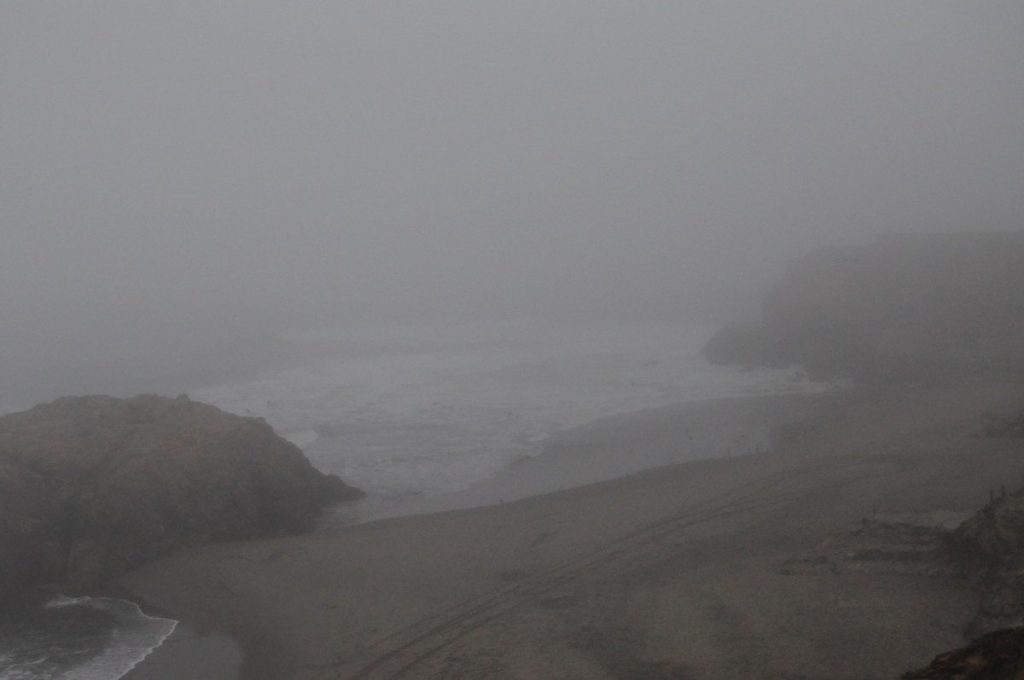
Fortunately the fog lifted just long enough for me to see Brown Pelicans, Brandt’s Cormorants, and a single Surfbird. Unfortunately, I knew there were other species on the water beyond the rocks, out of sight. We drove to the South Parking Lot along the Great Highway hoping to see scoters and loons but we could not see beyond the breakers. Our final stop was South Lake Merced, where we found Clark’s and Western Grebes and Marsh Wren. The Great-tailed Grackles and California Thrasher remained out of sight. Our final bird of the day was a Lincoln’s Sparrow near the parking lot.
At the end of the day I ended up with 76 species. While 76 species isn’t going to break any records, it was a really fun, if not exhausting, day! With better weather I think 100 species might be possible. And during a spring attempt when the birds are singing, 100 is surely within sight!
I raised a total of $945, over my goal, for Point Blue‘s Farallon Island research. Thanks to Julie and Mark for making the New York to San Francisco bird-a thon possible. And thanks to everyone who sponsored the City Tickers for this crazy event and made it all well worthwhile!
Alan Hopkins, an artist and former Golden Gate Bird Alliance board president, is co-compiler of the San Francisco Christmas Bird Count, which will take place this year on Tuesday, December 27. Alan will lead a bird walk in the Presidio in April 2017 as part of GGBA’s annual Birdathon. Check our web site in the spring for details about how to sign up and join him.
Here is the bird list from his NY-SF Big Day. Birds seen in both New York and San Francisco are listed where first seen: Park, New York
